Seeing Vancouver Island - and another funeral
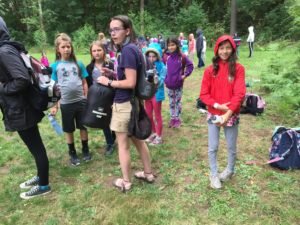 Several months ago, I arranged to do some travel pieces for publications interested in northern British Columbia. Ever since driving the AlCan two years ago (this month!), I’ve been fascinated with the region and wanted to go back, especially if I could get some payment for doing so. The first half of my trip involved spending four days driving up Vancouver Island, a place I hadn’t been to in many years and even then, it was mainly to Victoria on its southern end. Which is where many people go, but the publications I’d contacted wanted stuff more off the beaten path. Now Veeka had just come off a week spent at Girl Scout camp, so she was a bit done with camping, but I told her we'd be staying inside and sleeping in beds, so she was game to go traveling.The first leg involved driving from Seattle to the Tsawwassen ferry southwest of Vancouver, a three-hour ordeal. It was two hours to the border, a 45-minute wait there and then a half hour to the ferry. If you make reservations, you have to be there a half hour before boarding time, even though we didn’t actually drive on until about 10 minutes before the ferry pushed off. Finally arriving at the island just south of Nanaimo, I checked Foursquare (an app) for a place to eat.
Several months ago, I arranged to do some travel pieces for publications interested in northern British Columbia. Ever since driving the AlCan two years ago (this month!), I’ve been fascinated with the region and wanted to go back, especially if I could get some payment for doing so. The first half of my trip involved spending four days driving up Vancouver Island, a place I hadn’t been to in many years and even then, it was mainly to Victoria on its southern end. Which is where many people go, but the publications I’d contacted wanted stuff more off the beaten path. Now Veeka had just come off a week spent at Girl Scout camp, so she was a bit done with camping, but I told her we'd be staying inside and sleeping in beds, so she was game to go traveling.The first leg involved driving from Seattle to the Tsawwassen ferry southwest of Vancouver, a three-hour ordeal. It was two hours to the border, a 45-minute wait there and then a half hour to the ferry. If you make reservations, you have to be there a half hour before boarding time, even though we didn’t actually drive on until about 10 minutes before the ferry pushed off. Finally arriving at the island just south of Nanaimo, I checked Foursquare (an app) for a place to eat. It led us to an Italian bistro in Coombs, a small town on 4A west, about 5 miles west of Parkesville, but the place was packed and not taking walk-ins, so we repaired Billy Gruff’s Creamery nearby. Together with some Black Forest bread with lox and lemonade, that was our dinner. Across the way was the Old Country Market, where we saw billy goats literally standing on the roof of the place, contentedly eating grass. That certainly caught our attention as we drove up. It was a warm, lovely evening, the first of a four-day string of fabulous weather, which is not a given when you’re in that part of the world.The next day, we drove to Port Alberni, which is on an inlet off Vancouver Island’s west coast and dropped by Cathedral Grove, which was 800-year-old strand of Douglas firs surrounded by loads of tourists. Port Alberni is surrounded by peaks and we headed toward Harbor Quay. The day was sunny, breezy, mid-70s; in other words, heavenly. We got oysters and clam chowder and sat outside. There’s a bevy of picnic tables where you can snack from several eateries selling seafood, sit next to planters of purple, white and magenta petunias and listen to a fiddler’s band playing nearby.
It led us to an Italian bistro in Coombs, a small town on 4A west, about 5 miles west of Parkesville, but the place was packed and not taking walk-ins, so we repaired Billy Gruff’s Creamery nearby. Together with some Black Forest bread with lox and lemonade, that was our dinner. Across the way was the Old Country Market, where we saw billy goats literally standing on the roof of the place, contentedly eating grass. That certainly caught our attention as we drove up. It was a warm, lovely evening, the first of a four-day string of fabulous weather, which is not a given when you’re in that part of the world.The next day, we drove to Port Alberni, which is on an inlet off Vancouver Island’s west coast and dropped by Cathedral Grove, which was 800-year-old strand of Douglas firs surrounded by loads of tourists. Port Alberni is surrounded by peaks and we headed toward Harbor Quay. The day was sunny, breezy, mid-70s; in other words, heavenly. We got oysters and clam chowder and sat outside. There’s a bevy of picnic tables where you can snack from several eateries selling seafood, sit next to planters of purple, white and magenta petunias and listen to a fiddler’s band playing nearby. We drove back to a beach in Parkesville on the eastern side of the island, where the salty sea water was clear, and quite warm. The beach was strewn with logs and lots of pebbles and some rocks, but it was just right for my daughter to swim and it didn’t get deep until way out. The shimmering water, the Alaska cruise ship in the distance, the blues of the mountains, the water and the sky, the boardwalk that took one to a point out in the water; it was perfect for what we needed. There was a play area and tiny water park behind us, where my daughter frolicked plus there were food carts to grab a bite while you were covered with sand and wearing a suit. Parkesville and Qualicum Beach just north of that are noted for its nice beaches.The next morning, we drove to the northern end of the island, passing through Courtenay, Comox and Campbell River. None of the tourism brochures cover this area, a huge disservice to the folks who live in those parts and have businesses there. We detoured to a huge provincial area - Strathcona Provincial Park – to the west. We ended up at the Strathcona Park Lodge and Outdoor Education Centre, which overlooks the shimmering Buttle Lake that goes on for miles with snow-capped peaks of the Elk River Mountains – even in August – in the distance. This was such a lovely area with beautiful vistas to the west and south. I asked the person at the lodge check-in counter for some brochures and she told me to look online, which I thought was a bit cavalier. I can see why tourism is a bit lacking in these parts when some of the institutions in the area don’t work too hard at promotion! There’s a lot of hiking and camping available in the area, but you have to almost be a local to know what’s available.
We drove back to a beach in Parkesville on the eastern side of the island, where the salty sea water was clear, and quite warm. The beach was strewn with logs and lots of pebbles and some rocks, but it was just right for my daughter to swim and it didn’t get deep until way out. The shimmering water, the Alaska cruise ship in the distance, the blues of the mountains, the water and the sky, the boardwalk that took one to a point out in the water; it was perfect for what we needed. There was a play area and tiny water park behind us, where my daughter frolicked plus there were food carts to grab a bite while you were covered with sand and wearing a suit. Parkesville and Qualicum Beach just north of that are noted for its nice beaches.The next morning, we drove to the northern end of the island, passing through Courtenay, Comox and Campbell River. None of the tourism brochures cover this area, a huge disservice to the folks who live in those parts and have businesses there. We detoured to a huge provincial area - Strathcona Provincial Park – to the west. We ended up at the Strathcona Park Lodge and Outdoor Education Centre, which overlooks the shimmering Buttle Lake that goes on for miles with snow-capped peaks of the Elk River Mountains – even in August – in the distance. This was such a lovely area with beautiful vistas to the west and south. I asked the person at the lodge check-in counter for some brochures and she told me to look online, which I thought was a bit cavalier. I can see why tourism is a bit lacking in these parts when some of the institutions in the area don’t work too hard at promotion! There’s a lot of hiking and camping available in the area, but you have to almost be a local to know what’s available.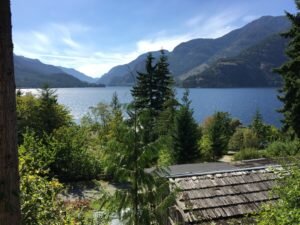 North of Campbell River is some 120 miles of wilderness and then two small towns: Port McNeil and Port Hardy. Our B&B was 19 miles to the west in Port Alice, an old pulp mill town, supplied by logging camps on nearby inlets. The folks at the Inlet Haven B&B were beyond helpful, driving us to nearby sites, letting us do laundry and – when it was clear there were no nearby restaurants in that tiny town where we could get dinner – fixed us a wonderful hamburger meal on their deck while the sun set over the mountains. At one point, 1,500 people lived there with about 500 employed by the mill. It finally closed in 2004, later re-opened, then shut down again in February 2015, which was unfortunately in that the mill provided 75 percent of the town’s tax base and half of its jobs. One of the casualties was Port Alice’s one restaurant.The area gets similar mild weather to its more famous neighbor, Victoria, to the south. It used to get copious amounts of rain, I was told, but not so this year; in fact, there was so little rain that the day we arrived, all open fires, even those on a beach, were banned.
North of Campbell River is some 120 miles of wilderness and then two small towns: Port McNeil and Port Hardy. Our B&B was 19 miles to the west in Port Alice, an old pulp mill town, supplied by logging camps on nearby inlets. The folks at the Inlet Haven B&B were beyond helpful, driving us to nearby sites, letting us do laundry and – when it was clear there were no nearby restaurants in that tiny town where we could get dinner – fixed us a wonderful hamburger meal on their deck while the sun set over the mountains. At one point, 1,500 people lived there with about 500 employed by the mill. It finally closed in 2004, later re-opened, then shut down again in February 2015, which was unfortunately in that the mill provided 75 percent of the town’s tax base and half of its jobs. One of the casualties was Port Alice’s one restaurant.The area gets similar mild weather to its more famous neighbor, Victoria, to the south. It used to get copious amounts of rain, I was told, but not so this year; in fact, there was so little rain that the day we arrived, all open fires, even those on a beach, were banned.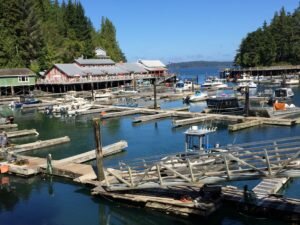 We spent two nights in Port Alice, using part of our free day to see Telegraph Cove, on the eastern side of the island, which was packed with sightseers who were on whale watching expeditions or fishing boats. The cove is an antique sawmilling village with buildings dating back to the 1920s and 1930s. We wandered about the Wastell House, an airy place with a sun room overlooking the harbor. The place is surrounded by forest and that day, clear sunlight poured down. However, the place is a tourist trap; we had to pay $1/hour to park in a crowded dirt lot in a resort in the middle of nowhere. I was told the fees went for the upkeep of the access road to the resort. Our host told us that when he bought a fishing license there, they charged him $5 to merely print it out.The next morning, we left Port Alice at 4:30 a.m. for the 45-minute drive to the ferry in Port Hardy. Boarding it was a disorganized mess. We got there just before 5:30, which I was told was the absolute hour one had to be there. The walk-on passengers were told the same thing. Drivers all sat, idling, in line for an hour. Starting around 6:30, we began inching forward. A lot of late-arriving cars were allowed in ahead of us, so it was quite arbitrary whether you were there early or not. When I asked the
We spent two nights in Port Alice, using part of our free day to see Telegraph Cove, on the eastern side of the island, which was packed with sightseers who were on whale watching expeditions or fishing boats. The cove is an antique sawmilling village with buildings dating back to the 1920s and 1930s. We wandered about the Wastell House, an airy place with a sun room overlooking the harbor. The place is surrounded by forest and that day, clear sunlight poured down. However, the place is a tourist trap; we had to pay $1/hour to park in a crowded dirt lot in a resort in the middle of nowhere. I was told the fees went for the upkeep of the access road to the resort. Our host told us that when he bought a fishing license there, they charged him $5 to merely print it out.The next morning, we left Port Alice at 4:30 a.m. for the 45-minute drive to the ferry in Port Hardy. Boarding it was a disorganized mess. We got there just before 5:30, which I was told was the absolute hour one had to be there. The walk-on passengers were told the same thing. Drivers all sat, idling, in line for an hour. Starting around 6:30, we began inching forward. A lot of late-arriving cars were allowed in ahead of us, so it was quite arbitrary whether you were there early or not. When I asked the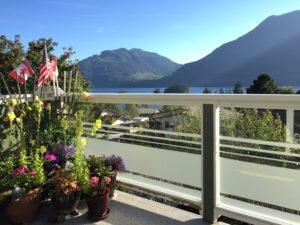 reasons for the delay, I was told many of the people driving the campers had put given the wrong vehicle lengths on their reservations (one has to specify rough measurements), meaning they had to recalibrate how much room they had on the ferry. I was also told even children needed individual IDs. Being foreigners, we had passports, but what if we hadn’t? I explained U.S. kids don’t have separate IDs, which got me a stare from the ferry folks. Not only did they slowly check us in at the first gate, they re-checked us a few hundred feet later as we boarded, as if extra people had snuck into the car. The attendant explained the parking lot was unsecured, although the fencing looked pretty good to me. Maybe they figured terrorists had somehow gotten up at 5 a.m. to burrow underneath. We boarded around 6:55 and the ferry left around 7:40. Most inefficient operation ever.
reasons for the delay, I was told many of the people driving the campers had put given the wrong vehicle lengths on their reservations (one has to specify rough measurements), meaning they had to recalibrate how much room they had on the ferry. I was also told even children needed individual IDs. Being foreigners, we had passports, but what if we hadn’t? I explained U.S. kids don’t have separate IDs, which got me a stare from the ferry folks. Not only did they slowly check us in at the first gate, they re-checked us a few hundred feet later as we boarded, as if extra people had snuck into the car. The attendant explained the parking lot was unsecured, although the fencing looked pretty good to me. Maybe they figured terrorists had somehow gotten up at 5 a.m. to burrow underneath. We boarded around 6:55 and the ferry left around 7:40. Most inefficient operation ever. Once on, it wasn’t a bad 16-hour trip. A public address system occasionally alerted passengers to bear and whale sightings plus historic tidbits about which early Canadian explorer named which cove we were passing by. The salmon were clearly running and we could see them soar out of the water in quick half-circles. The weather was clear and sunny – not a given in the Pacific Northwest by far – and the boat hosted a BBQ for lunch which was a pleasant break from the cafeteria. Many of us took refuge on the glassed-in sundeck on the 6th floor to gaze at hundreds of miles of forested mountains, occasional lighthouses, canneries, waterfalls and scattered settlements. We met the most pleasant family from London: Gordon and Stephanie and their 5-year-old daughter, Flo, who spent much of the day playing with my daughter.We weren’t released from the boat until close to midnight and then I drove about Prince Rupert, which seems to fog over at night, searching for the Black Rooster, our hostel. I could barely read the street signs and either the lights were dim or the fog was heavy, but it was very hard to find my way about town. Even the next day, sans fog, I noticed a lot of the streets lack signs. As for the next leg of our journey, that comes in the next blog!
Once on, it wasn’t a bad 16-hour trip. A public address system occasionally alerted passengers to bear and whale sightings plus historic tidbits about which early Canadian explorer named which cove we were passing by. The salmon were clearly running and we could see them soar out of the water in quick half-circles. The weather was clear and sunny – not a given in the Pacific Northwest by far – and the boat hosted a BBQ for lunch which was a pleasant break from the cafeteria. Many of us took refuge on the glassed-in sundeck on the 6th floor to gaze at hundreds of miles of forested mountains, occasional lighthouses, canneries, waterfalls and scattered settlements. We met the most pleasant family from London: Gordon and Stephanie and their 5-year-old daughter, Flo, who spent much of the day playing with my daughter.We weren’t released from the boat until close to midnight and then I drove about Prince Rupert, which seems to fog over at night, searching for the Black Rooster, our hostel. I could barely read the street signs and either the lights were dim or the fog was heavy, but it was very hard to find my way about town. Even the next day, sans fog, I noticed a lot of the streets lack signs. As for the next leg of our journey, that comes in the next blog!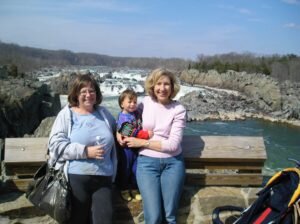 One thing I did want to add is that earlier in August, a dear friend, Julie Kay, died of ovarian cancer at the age of 54. I was with Veeka in Quebec when a mutual friend called to say she was dying and if I wanted to see her, I had to fly to Florida right then. Of course that was impossible for me, so I called around to other friends, who told me that Julie had been so secretive about her illness, very few people knew that she'd battled this thing for 10 years. She certainly had not told me she was dying, although our last conversation - where she called to express sympathy on the death of my dad - was very odd and now as I think of it, she was surely thinking of her own impending death. Yet, she said nothing to me of it and I am of course kicking myself that I didn't question her further at the time. Julie was one of those friends I knew from my Florida days. I've moved around so much in my life, most people I've known have ceased communicating with me. But Julie was amazing in that she pursued and kept long-time friends. She visited me in Maryland; I visited her in Florida and we shared trips together to Key West and Oaxaca, Mexico. Again, it's the same lesson that man - and woman - knows not their time and when they may be called.
One thing I did want to add is that earlier in August, a dear friend, Julie Kay, died of ovarian cancer at the age of 54. I was with Veeka in Quebec when a mutual friend called to say she was dying and if I wanted to see her, I had to fly to Florida right then. Of course that was impossible for me, so I called around to other friends, who told me that Julie had been so secretive about her illness, very few people knew that she'd battled this thing for 10 years. She certainly had not told me she was dying, although our last conversation - where she called to express sympathy on the death of my dad - was very odd and now as I think of it, she was surely thinking of her own impending death. Yet, she said nothing to me of it and I am of course kicking myself that I didn't question her further at the time. Julie was one of those friends I knew from my Florida days. I've moved around so much in my life, most people I've known have ceased communicating with me. But Julie was amazing in that she pursued and kept long-time friends. She visited me in Maryland; I visited her in Florida and we shared trips together to Key West and Oaxaca, Mexico. Again, it's the same lesson that man - and woman - knows not their time and when they may be called.